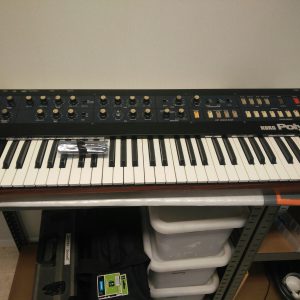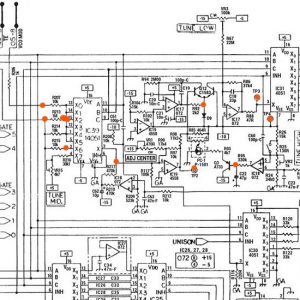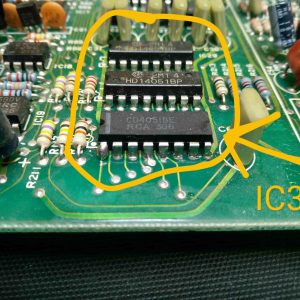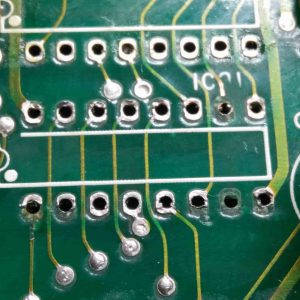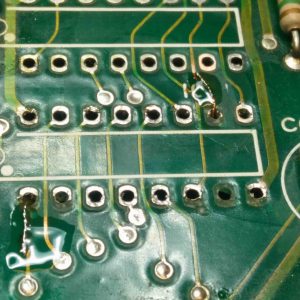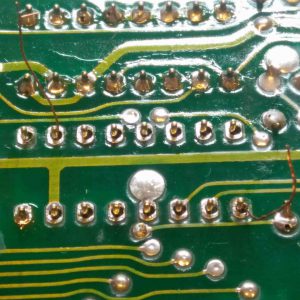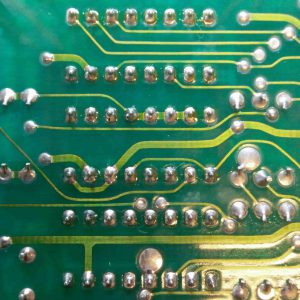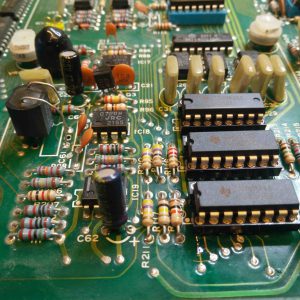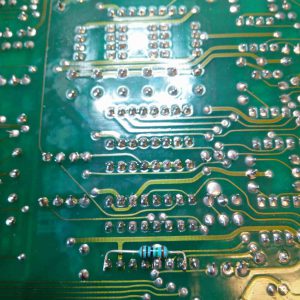This Korg Polysix synthesizer was sent to me and behaved strange; all the oscillators pitch appeared to have an unwanted modulation and it appeared more clearly with the higher notes. All the patches had the same problem.
As a first step I checked out the voltages for deviations and ripple. I wasn’t convinced of what I saw on the oscilloscope (little ripple and noise) and to rule out the power supply to be the culprit, it was best to change out the capacitors. When we got clean power the problem still persisted. The problem had to be somewhere else and I suspected it to be somewhere in the multiplexed 0.5V/Hz or antilog area on KLM-366. I could see wobbly voltage on high notes sent to the different voices. The wobbly modulation was also present on the multiplexed high note voltages. C22 and C62 were replaced, without luck. With replacing those capacitors I saw that the optocoupler PC-1 and the IC31 4051 demultiplexer have been replaced in the past. Around PC-1 but especially IC31 was a lot of flux residue which hasn’t been removed after the solder job. With a closer look at IC31 it was clear that the replacement was done very sloppy, more than a few solder joints didn’t have enough or had too much solder on them. Since this IC is clearly very important and could be the culprit if it wasn’t functioning properly, I had to be sure that it was properly soldered. I decided to remove the solder and the chip and to reseat it. After carefully desoldering the chip more problems raised. The ‘technician’ who took out the original chip in the past probably took some copper pads and tracks with it! Those tracks and pads had to be repaired. Another, still original, 4051 multiplexer chip (IC39, sitting right next to IC31) also had some weird solder joints. Even a third 4051 chip was sitting next to those two 4051s, so I thought it would be best to change all three of them with new socketed replacements. The damaged tracks have been repaired and shouldn’t be any problem now, especially since I soldered sockets on the board to put the new chips into. Now I was confident that I could rule out the badly done previous repair. Unfortunately the modulation was still there. After a lot of measuring and thinking, I started to suspect the optocoupler PC-1, which has been replaced with another model someday in the past, since the modulation was more present with high notes, hence the logarithmic tuning scale. The modulation was also present on the demuxed voltage at pin 2 of the newly replaced IC31. With hunting down the modulation I only used the scope. At some point I took my digital multimeter to measure the voltages in between IC39 and IC31. I found out that the modulation went away when measuring the voltage between the right side of R96 and ground. Since the synthesizer ‘sees’ the DMM as a high Megaohm resistance, I tried to recreate a simple modification with placing a 10Mohm resistor between pin2 and pin8 (ground) of IC31. I don’t exactly know why this junction needs a very small reference to ground but it works. The downfall is that because of this modification the synthesizer needed a fresh tuning calibration. The tuning was kind of difficult but it worked. I believe that the curves of the currently installed photocoupler does not very well match with the original vactrol, what results in a hard to tune Polysix synthesizer. Since the synthesizer is in tune now, I left this one alone.
